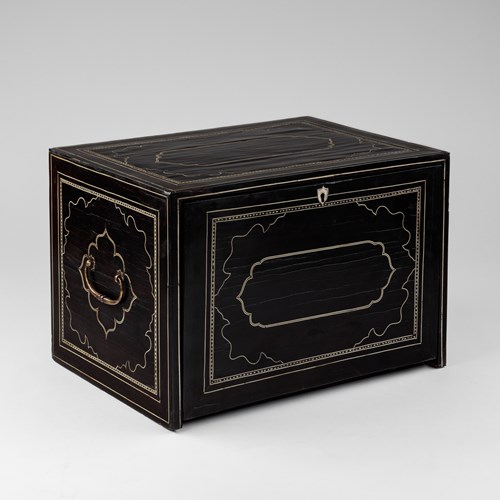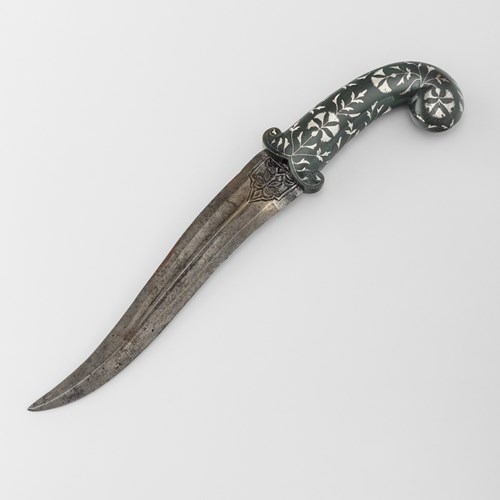Raja and Courtesan
Date 1680-85
Epoque 17th century
Origine Bikaner, Rajasthan, India
Medium Ink, opaque watercolour on paper
Dimension 33 x 26.5 cm (13 x 10³/₈ inches)
The meticulously rendered jewellery displayed here is remarkably varied: the emeralds on the raja’s turban band and pair of royal sarpeches, the ruby bugadi at the top of his ear, the familiar two-pearl earring, and the double-strand pearl and gem necklaces about his neck and chest. The female is bejewelled almost as opulently, with a string of pearls running along the part in her hair (sir maga) and terminating in a circular ornament (tikka), a graceful nose-ring (nath), a large circular earring (karnphool or ‘ear-flower’), a double-strand pearl necklace with a large emerald pendant, and the ostentatious hathphool (‘flower for the hand’) on the back of each hand. The brilliant bits of white, green and gold in the jewellery establish a staccato surface rhythm that is extended subtly in the tiny circles that form diamond patterns and beaded borders on her tie-dyed diaphanous odhani (veil). All these forms stand out from the thinly painted turban, the raja’s tight-fitting upper garment and the woman’s sheer choli.
The figures are presented as both tipsy and coy, qualities conveyed by wide, half-shuttered eyes, the woman’s sidelong glance and the slight incline of her head away from her paramour. The figures’ faces, arms and hands are drawn with crisp precision and are modelled selectively, most skilfully around the eyes, mouth and jaw, but most distinctively in the arching yellowish brushstrokes spanning the raja’s upper arm and forearm. The male’s features and facial hair are adapted from those of Maharaja Anup Singh of Bikaner (b. 1638, r. 1669-98), a conceit that appears frequently in Rajasthani painting.2
This marvellous painting relates most closely to a painting ascribed to Hasan Raza, one of the two sons of ‘Ali Raza, a highly accomplished early Bikaner artist.3 That work, now in the National Museum of India, New Delhi, presents an equally large-scale frontal portrait of a beauty with a very similar treatment of her eyes, mouth, nose and hair. A bust-length portrait of a lady in profile view attributed to this same artist was offered in our 2019 catalogue.
Date: 1680-85
Epoque: 17th century
Origine: Bikaner, Rajasthan, India
Medium: Ink, opaque watercolour on paper
Dimension: 33 x 26.5 cm (13 x 10³/₈ inches)
Provenance: Private European collection by descent since the 1940s
Literature: Footnotes:
1. Published in Gerd Kreisel. 1995. Rajasthan: Land der Könige. Stuttgart: Linden Museum Stuttgart. Abb. 111.
2. See Maharaja Anup Singh on Horseback, Bikaner, c. 1690, published in the frontispiece in Hermann Goetz. 1950. The Art and Architecture of Bikaner State. Oxford: Bruno Cassirer.
3. Published in Karl Khandalavala, Moti Chandra, and Pramod Chandra. 1960. Miniature Paintings from the Sri Motichand Khajanchi Collection. New Delhi: Lalit Kala Akademi. no. 90, fig. 71.
Plus d'œuvres d'art de la Galerie




_T638815391591372611.jpg?width=500&height=500&mode=pad&scale=both&qlt=90&format=jpg)

_T638793797436904297.jpg?width=500&height=500&mode=pad&scale=both&qlt=90&format=jpg)


